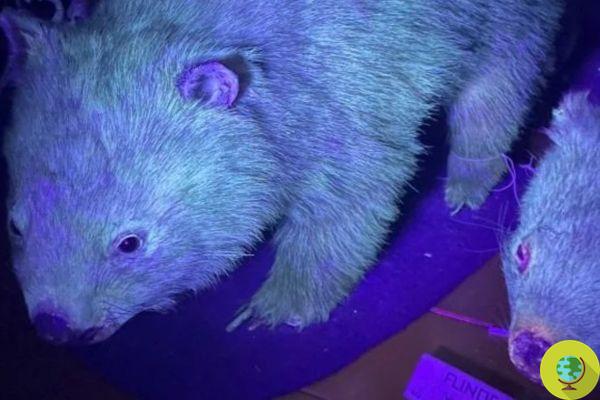
Other tests conducted by Australian colleagues revealed that other mammals and marsupials also shine: they are biofluorescent
He is about to end up run over, his mother saves himFollowing the accidental discovery by American scientists that platypuses glow under UV light, other tests conducted by Australian colleagues revealed that other mammals and marsupials also glow - they are biofluorescent.
It has long been known that biofluorescence is typical of some insects and marine creatures, but it was not known to also occur in Australian mammals until earlier this month, when scientists at the Western Australian Museum accidentally noticed that wombats as well. they shone. Australian scientists at the Museum of Western Australia found that along with ornithorns, wombats and other marsupials in the dark also all become beautifully fluorescent (green, blue and pink) under UV light.
In recent years, scientists have discovered that biofluorescence is more common among mammals than we realized - with flying squirrels glowing pink with chewing gum, prompting researchers to see how long this trait has existed in our genetic makeup. They started with animals such as the platypus (Ornithorhynchus anatinus), the oldest surviving mammalian lineage.
Of course, once the platypus's glow was revealed, other researchers such as the Mammalogy curator of the Western Australian Museum, Kenny Travouillon and biologist Linette Umbrello, pointed UV rays at several specimens in the museum's collections. And so far their findings have been far from disappointing:
The glowing wombats are also some of my favourite! #wombat #uv pic.twitter.com/XdgLqAoorX
— Dr. Kenny Travouillon (@TravouillonK) November 5, 2020
Not only vombati. They were also biofluorescent echidne and some marsupials such as bandicoots and Macrotis, possums and some bats. Australian creatures join a host of other living things that glow, including insects, frogs, fish and fungi.
La biofluorescence it should not be confused with the bioluminescenza, which is triggered by a chemical reaction and can occur even in the complete absence of external light. A classic example of bioluminescence are fireflies and that of deep-sea marine fauna.
Biofluorescence, on the other hand, occurs when a living being absorbs high-energy radiation such as ultraviolet and therefore emits light at a lower frequency. Many proteins have been identified that can do this in skin or other animal tissues, including bones and teeth, Australian Museum forensic scientist Greta Frankham told ScienceAlert.
“There are chemical compounds in many different parts of the animal's body that appear to be fluorescent, so it's not surprising to find that there may be other chemical compounds in other things like fur,” Frankham said.
Scientists have isolated some of these molecules and used them for scientific imaging, but they still don't know how and why biofluorescence occurs in these mammals. But however it is achieved, it certainly produces surprisingly bright results in UV light, like the ears and tail of this Bilby (Macrotis leucura).
After platypus was shown to glow under UV light, couldn’t resist trying bilbies… their ears and tails shine bright like a diamond! #bilby #uv pic.twitter.com/wL82RDdFYb
— Dr. Kenny Travouillon (@TravouillonK) November 3, 2020
“Predators don't seem to shine. I think this is because if predators could be seen, they would lose any chance of catching their prey, ”Travouillon speculated.
Frankham pointed out, however, that many marsupials are nocturnal, so this may not necessarily be a driving factor in the evolution of this trait.
Field studies are needed to examine whether there are any advantages or disadvantages of this ability within the natural environment but given how vulnerable many of these Australian species are, it is worth knowing whether or not this trait affects their ecology.
Sources of reference: ScienceAlert
READ also:
- They annoy a farmer: 200 wombats will be culled in the aboriginal lands of Australia
- Australia: the harrowing video of the charred wombat crossing the road in search of food while fleeing the fires


























